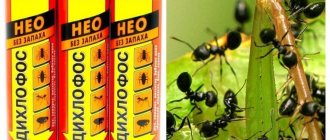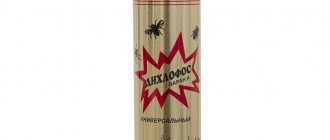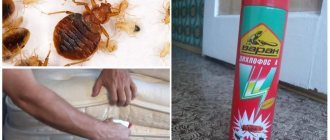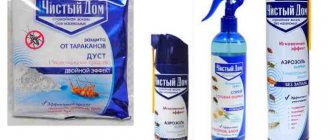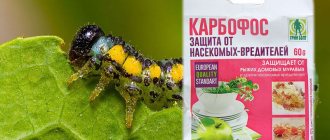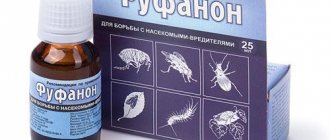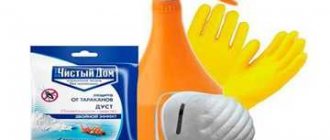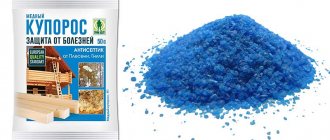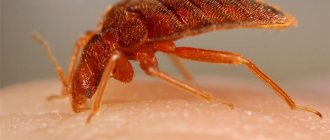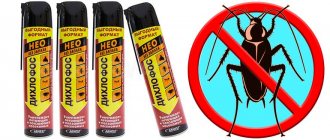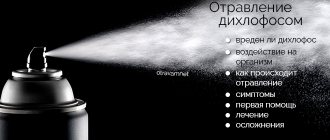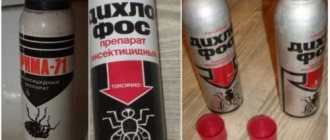The modern remedy, under the name “Dichlorvos”, familiar from childhood, has inherited, perhaps, only the name itself and unprecedented popularity. Now the drug "Dichlorvos" is based on a completely different composition, it is not so toxic and asphyxiating.
Of course, it has not lost its former effectiveness, otherwise people would have stopped buying it long ago. For those who plan to purchase “Dichlorvos” for bedbugs, it will be useful to know the capabilities of this product to completely remove bloodsuckers, as well as the features of its use.
What is Dichlorvos
The disinfectant has been known since the time of our grandmothers, but even now it has not lost its popularity. Dichlorvos is ideal for controlling parasitic insects in the house. The name of the drug comes from the main component - dichlorovinyl phosphate. Dichlorvos for fleas, produced previously, had a pungent odor, but today drugs without a toxic odor have been invented that are no less effective against pests.
The use of a product based on dichlorovinyl phosphate has a detrimental effect not only on fleas, but also on flies, mosquitoes, ants, cockroaches or bedbugs. According to the instructions, the room should be treated with the windows and doors closed. The aerosol stream should be directed to the affected area, that is, splashing around the entire perimeter of the room. If you want to get rid of flying insects, then spray Dichlorvos in the air.
Insect control
Dichlorvos is a universal drug that acts on different types of insects. But for each you need to choose your own approach: this is how the treatment of the room will be most effective.
Bedbugs
Bedbugs are blood-sucking parasites; the poison cannot enter their body with food. Dichlorvos will work if you spray all surfaces with which uninvited guests come into contact. It is also necessary to find nests - this will help destroy most of the uninvited guests. Typically, bedbugs live in sofas, beds, armchairs and other upholstered furniture, mattresses, bed linen, old furniture, and books.
To get rid of bedbugs using Dichlorvos, you need to:
- Free up hard-to-reach places.
- Find nests.
- Spray them at a distance of about 25 cm.
- Repeat treatment after 7-14 days.
The chemical is also effective in the fight against bed bugs. To withdraw them, follow these instructions:
- Remove bed linen.
- Wash it at high temperatures, treat it with an insecticide, wash it again.
- Remove the mattress.
- Find a nest of bed bugs.
- Spray it with spray.
- Treat the sleeping area.
- Leave for 3-4 hours.
- Ventilate the room.
- Wipe furniture and floors with a damp cloth soaked in a solution of 0.5 pieces of laundry soap and 1 liter of water.
- After 1.5 -2 weeks, re-treat.
Advice! During the treatment period, it is better to sleep in a different place.
Before poisoning bedbugs, warn your neighbors about this if you live in an apartment building. Uninvited guests may run to nearby apartments to escape the poison. It is best if neighbors begin to remove parasites at the same time and take preventive measures.
Cockroaches, ants
The effect of Dichlorvos on cockroaches is not so effective; it is best to combine the aerosol with other means, for example, traps.
Insects die when they come into contact with the insecticide. It is necessary to treat all surfaces where they have been. Most often, cockroaches live in the kitchen, in which case you need to act very carefully: you must not allow the poison to get into your food or dishes. Use an odorless chemical to prevent it from becoming embedded in your kitchen furniture.
Dichlorvos against cockroaches will help if you follow the instructions:
- Deprive pests of access to water - cockroaches will not live long without liquid.
- Remove all dishes, or at least cover them with plastic wrap.
- Remove food from the kitchen.
- Clear all hard-to-reach places.
- Spray all cracks, baseboards, corners, cabinets, shelves.
- Treat floors and walls.
- Close the room, leave it.
- After 1.5-2 hours, ventilate the kitchen.
- Carry out wet cleaning with a solution of 0.5 bars of laundry soap and 1 liter of water.
- Repeat the procedure for removing cockroaches after 2-3 weeks.
The principle of operation of Dichlorvos against ants is similar: you need to spray the aerosol in the room where insects were seen most often.
However, there are some nuances here:
- To effectively get rid of an ant colony, you need to find the nest where the queen lives. There may be several such places. The chemical is sprayed over the nest at a distance of 20-30 cm;
- Foraging ants usually remember the path from the nest to the food source and always use it. By observing the habits of insects, you can find their habitat.
Attention! As with bedbugs, warn your neighbors before poisoning cockroaches and ants. These insects can also move into neighboring apartments.
Fleas
Dichlorvos against fleas helps when all their habitats have been thoroughly treated. Pests usually hide in pet bedding, on carpets, rugs, and behind baseboards. To get rid of fleas, you need to spray the product on these objects, walls, furniture up to 1 m high. These pests can jump high, so if you miss a section of the wall or habitat, the fleas will return very soon.
Do not spray the chemical near food bowls. Bedding and blankets must be washed well at high temperature 1-2 weeks after flea removal. Before washing, pets should not be allowed on them; people should also limit contact with treated items.
Attention! To completely destroy fleas, you need not only to treat the surfaces, but also to remove pests from the animal’s fur. Use special drops, a collar, and shampoo.
Flies, mosquitoes, wasps
Dichlorvos helps against the invasion of wasps, mosquitoes, flies, and midges in the apartment. To get rid of flying individuals, follow these recommendations:
- Apply the product to the areas where most pests are usually found.
- Spray the product around the apartment.
- Leave for 3-4 hours, during which time residents should not be at home.
- Ventilate all rooms.
- After 30-60 minutes, carry out wet cleaning.
Repeat this procedure after 6-7 days to ensure that flies, midges and wasps are removed.
Attention! To get rid of mosquitoes, it is more convenient to use safer means, for example, fumigators. They act just as effectively, but cause much less harm to health.
Mole
To get rid of moths using Dichlorvos, you need to:
- Remove all clothes and shoes from the closet.
- Take fur and fur coats out onto the balcony or street.
- Spray the chemical inside.
- Leave the cabinet closed for 2-3 hours.
- Spray a large fabric or clothing cover with the aerosol.
- Cover fur items with this material so that they absorb the smell.
- Open the cabinet doors and leave the windows in the room open to ventilate the furniture a little.
- Wipe the shelves with cleaning liquid.
- Repeat treatment after 3-4 weeks.
In addition, the product is used as a prophylaxis. Before storing wool or fur, wrap it in paper sprayed with poison.
The insecticide is allowed to be used only for clothes and textile moths. It is highly undesirable to use it on kitchen cabinets and shelves, as the product remaining on them will poison food. Floors and baseboards can be sprayed, but before doing this, you must remove all food from the room and use the room less often for 2 weeks after spraying.
Attention! To protect your cabinets from moths, place bags of dried lavender and dried citrus slices on the shelves.
Lice
Dichlorvos also helps get rid of body lice. It effectively kills adults, but is completely harmless to nits - parasite eggs have a special protective shell, so the treatment must be repeated 2-3 times every 2-3 weeks.
You can remove body lice with Dichlorvos as follows:
- Place contaminated items in large plastic bags.
- Spray an aerosol inside them.
- Leave for 1-2 hours.
- Wash on high temperature.
- Iron at the maximum permissible setting.
It will not be possible to remove lice on the head with Dichlorvos, since the chemical is very toxic, causes skin irritation, peeling, and often leads to hair loss. There are more convenient and safer remedies for head lice.
Other insects
The insecticide also helps get rid of other annoying insects, both in the house and in the garden.
For example, Dichlorvos is used to remove spider mites from indoor plants. Instructions for use are as follows:
- Cover the plant with a cardboard cone or plastic bag.
- Make a small hole in it.
- Spray the flower with insecticide.
- Leave for 5-7 minutes.
- Remove the cap and bag.
- Repeat treatment after 6-8 days.
Attention! If possible, use another product, as the drug is harmful to plants and soil.
Dichlorvos will help remove spiders and double-wort, but the former are not so susceptible to the chemical. Follow this procedure:
- Spray the poison in all hard-to-reach places, especially damp and warm ones.
- Treat areas where traces of two-wort or cobwebs were noticed.
- Leave the apartment for 2-4 hours.
- Ventilate the rooms.
- Wipe floors and walls with a damp cloth.
Another way to use Dichlorvos is to kill aphids on roses. It is necessary to treat flowers according to the instructions, just like indoor plants when spider mites appear. In this case, there is no need to cover the plant with a cone, because the processing takes place in the fresh air.
Again, the chemical is quite aggressive, it is better to use less toxic products.
Ants from the garden are also removed with Dichlorvos. To do this, spray the product over the anthill and around it.
How does a flea treatment based on dimethyldichlorovinyl phosphate work in the home?
A powerful insecticide called Dichlorvos leaves no chance of survival for any flea. The drug based on dimethyldichlorovinyl phosphate is considered safe for humans and warm-blooded animals if used according to the instructions, but lethal for insects. There are several varieties of Dichlorvos on sale with the prefixes “Neo”, “Eco”, “Super”, “Varan”, which, compared to the Soviet-era drug, are more effective, but not toxic.
Based on the experience of past generations, it is not for nothing that modern people trust Dichlorvos. The drug, getting on the surface of the flea, paralyzes it and leads to inevitable death. The product helps fight adults and their larvae, but does not pose a danger to the eggs and pupae of the parasite, because the latter are protected by a heavy-duty shell. If you decide to completely eradicate fleas, then the can of Dichlorvos should be re-sprayed a few weeks after the first time to get rid of the grown parasites.
The effect of dichlorvos on cockroaches from modern spray cans
99% of the so-called “dichlorvos” consist of synthetic pyrethroids that are safer for humans: ranging from permethrin and other low-toxic compounds, ending with cypermethrin, to which many populations of cockroaches have already developed resistance.
In order for the product to be allowed to be sold to the public, the manufacturer has to seek a compromise between effectiveness and harmlessness, because the aerosol significantly increases the hazard class of any insecticide, especially organophosphorus. It remains to either include the least toxic components in the composition, or significantly reduce their concentrations.
Today, insect repellent cans do not contain FOS insecticides, since their use in aerosol form increases the hazard class.
How does dichlorvos work on cockroaches?
Most products in aerosol packaging, including those labeled “dichlorvos,” have a short-term lethal effect on insects and are mainly aimed at repelling results. Cockroaches are more likely to be afraid of dichlorvos than to die from it. And, judging by consumer reviews, every year dichlorvos is less and less effective against them.
In addition, one cannot count on a residual effect. The chemical composition decomposes too quickly when exposed to sunlight, humidity and high temperatures.
Despite this, experience with use and individual reviews indicate that dichlorvos helps some people against cockroaches.
Instructions for use of Dichlorvos
Do not forget that Dichlorvos for fleas is, first of all, poison, so it must be used carefully. Keep in mind that one can of aerosol is enough for ten square meters of room. The standard treatment procedure with an insecticide based on dimethyldichlorovinyl phosphate will be harmless to your health if you follow the step-by-step steps:
- put dishes and food in cabinets;
- put on clothes that will completely cover your legs and arms, don’t forget about gloves, a face mask;
- doors and windows must be tightly sealed;
- only after this, spray the aerosol on all surfaces of the room: floor, furniture, walls, spray one and a half meters into the air;
- pay special attention to the far corners and the space under the baseboard - this is where fleas most like to live;
- It is recommended to treat carpets on both sides;
- leave the house for an hour or two;
- after returning, thoroughly ventilate the room, preferably creating a draft;
- do dry cleaning, for which a vacuum cleaner is best suited;
- Tie the dust bag into a bag and throw it away.
- What is slow carbohydrates?
- How to properly apply a compress to the ear
- Turmeric - what it is, beneficial properties and contraindications. Uses of turmeric
How to treat an apartment with Dichlorvos correctly
It is advisable to treat a heavily infested room with fleas twice, but with an interval of one to three weeks. Each time you must strictly adhere to the instructions for use. Modern substances are harmless to animals and humans, so if after treating the room a small amount of the drug remains, then there is nothing wrong with that. Proper cleaning of an apartment with the presented insecticide consists not only in step-by-step instructions, but even in the method of applying the aerosol. You can completely remove fleas if:
- carefully walk the product along the back walls of the furniture;
- treat carpets on both sides, but first shake out and wash;
- do not forget to treat cracks in walls and baseboards;
- spray Dichlorvos on soft furniture elements, such as mattresses, headboards, pillows;
- the internal structures of cabinet furniture are also subject to treatment;
- fleas jump high, so you need to grab the wall one and a half meters high.
How long does it take for Dichlorvos to erode?
Each container with Dichlorvos contains not only instructions for use, but also the time that the drug is in the room. The substance evaporates after the first thorough ventilation. There will be no trace of the insecticide if a draft blows through the room for fifteen minutes. Do not think that modern odorless aerosols do not require ventilation of the room. In any case, fresh air should fill the room.
First aid
If dichlorvos gets into your eyes:
- rinse your eyes thoroughly with water, or saline, or a two percent soda solution (1 tsp of soda for 1 cup of water);
- drip Albucid or some other medicine for eye inflammation into the eyes;
- if necessary, apply a blindfold;
- consult an ophthalmologist.
If dichlorvos gets on your skin:
- wash the affected area with water and soap or a two percent soda solution;
- Do not rub the affected skin too hard under any circumstances: this helps the poison penetrate into the deeper layers of the skin;
- remove all clothing that the person was wearing at the time he was infected with dichlorvos, as particles of poison may remain on them.
If a person has inhaled dichlorvos vapor:
- take the person out into the fresh air;
- remove all clothing that the person was wearing at the time he was infected with dichlorvos, as particles of poison may remain on them;
- the victim should rinse his mouth and nose, rinse all exposed parts of the body with water, as dichlorvos molecules may get on them;
- the victim should lie down in bed and calm down.
If dichlorvos gets into the digestive tract:
- give the victim plenty of clean water to drink;
- induce vomiting;
- give any adsorbent drugs;
- one hour or an hour and a half after the sorbent, give a laxative based on salt: magnesia, Glauber’s salt;
- It is also useful to do an enema, but only if the victim himself or someone nearby knows how to do it, otherwise the patient can be further injured;
- again give plenty of clean water or tea, jelly to drink;
- put the patient to bed and provide him with peace.
The victim should eat light natural food for several days and be sure to drink kefir to restore the intestinal microflora.
With a small amount of dichlorvos ingested, you can do without medical help, much less hospitalization. After two or three days the person recovers completely. But if a child who is not even a year old is poisoned, a doctor is definitely needed. In older children, intoxication can also develop very quickly due to their weak immunity, so for the complete safety of children it is better to seek advice from a specialist.
If an allergic person is poisoned, in addition to other measures of assistance, he should be given antiallergic medications as soon as possible. Tavegil or suprastin, antihistamine ointments for the skin are suitable if the chemical gets on it.
How to choose Dichlorvos for fleas
It is worth immediately understanding that the Soviet-era product is no longer produced, because the drug had a high degree of toxicity to humans. They were replaced by substances based on dimethyldichlorovinylphosphate, but with an improved formula, which are considered harmless to warm-blooded mammals, but not to fleas. To kill insects, you can safely use the following types:
- Dichlorvos odorless Neo. It is fast-acting, so within just a few minutes you can see positive results from use. The drug works on the basis of cypermethrin and piperonyl butoxide. However, for an instant effect you will need to pay a price several times more than when purchasing a universal aerosol.
- Flea spray Universal. The good thing is that at a low cost, you can destroy a wide range of insects. Fleas, flies, cockroaches, bedbugs and other unwanted guests of apartments or houses are afraid of him. The price and effect are excellent, but the smell is unpleasant.
- Insect repellents in the apartment Eco or Super. Designed for a wide range of insects, but at the same time they have a pleasant lavender scent. The inexpensive price for one can makes the substance accessible to every buyer.
Find out how to choose the right flea treatment in your apartment.
Advantages and disadvantages
Dichlorvos has both advantages and disadvantages.
Among the advantages are:
- fast, complex impact;
- Ease of use;
- relative safety for humans;
- the presence of biodegradable components that do not generate toxic waste after use;
- versatility;
- duration of action.
The drug has the following disadvantages:
- the need to process the room several times to achieve results;
- the likelihood of allergic reactions: itching, redness of the skin;
- acrid odor;
- remains on surfaces for a long time, which is especially bad if there is a small child or pets in the house;
- harm to humans after prolonged contact with the drug.
Price of Dichlorvos for fleas
The drug is often used to combat fleas, which periodically interfere with the lives of even those people who do not keep animals in their apartment. At a low price, the product gives a 100% result and destroys many parasitic insects, so it is better to give preference to it over foreign analogues. An aerosol that can easily kill all harmful insects can be purchased at a store selling household goods or ordered from an online store. The average price will be:
- Neo – from 190 to 200 rubles;
- Station wagon – 60 rubles;
- Eco - 60 rubles.
Why doesn't dichlorvos kill cockroaches?
As we have already found out above, dichlorvos does not affect everyone equally. Some cockroaches will die immediately, others will flounder on their backs for another 12 hours, others will climb onto the ceiling and calmly sit there, and others will run to their neighbors through the ventilation.
The low efficiency of aerosol cans is explained by at least two factors:
- features of the form of the drug, namely the short-term action of the aerosol - droplets quickly settle and evaporate
- chemical composition - light pyrethroids are put into aerosol cans, which only “invigorate” the insects, and at the same time quickly disintegrate.
However, these are not all the reasons. Purely biological factors should also be included here. And in this regard, it makes absolutely no difference what product is used. Let's take a closer look at them.
Factors of biological ineffectiveness
Every animal on Earth, in the struggle for existence, is forced to overcome unfavorable environmental conditions. And cockroaches are no exception.
From the point of view of evolutionary biology, the driving factor in this struggle is natural selection, in which the most sensitive cockroaches to poison die faster than others. Consequently, they do not have time to produce offspring similar to themselves - i.e. which would remain vulnerable to chemicals. And they die out. With each extinction, their place in the population is taken by more and more tenacious individuals with fixed variability.
Red cockroaches are so adaptive that their survival after persecution is fixed at the genetic level. It can be expressed in different ways - irritability or resistance.
- Irritability is the increased sensitivity of a cockroach, expressed in avoiding contact with poison, and, as a result, not receiving a lethal dose. This ability is natural for any living organism, is physiologically determined and may not be inherited.
- Resistance is the increased resistance of a cockroach, or the ability to neutralize an insecticide and safely remove it from the body. It is determined only genetically.
Both of these reactions are inherited by different genes and are reflected in different parts of the chromosomes, depending on the insecticidal group.
How does this happen? Surviving individuals give birth to offspring - larvae, in whose DNA certain mutations have occurred. The mutated chromosome allows the cockroach to neutralize the effects of toxic substances. The next generation will certainly inherit this gene. Thus, “immunity” to poisons of one or another composition is fixed and passed on from generation to generation.
Dichlorvos acts primarily on physiologically weakened cockroaches, and achieves 100% mortality for them. Do other individuals die? Of course not, the most resistant of them will “get over the disease”, survive and give birth to offspring that inherit this trait.
T. V. Shapovalov, biologist
Chemical composition of the product
The first "Dichlorvos" appeared on store shelves more than 30 years ago, and its basis was dimethyl dichlorovinyl phosphate. It did an excellent job of killing insect pests, but the toxic effect on humans and pets was too significant.
This made its use in residential premises a very dangerous undertaking, and the stinking smell after it had to be aired out for quite a long time.
Modern insecticides produced under this brand are no worse at poisoning cockroaches, but thanks to completely different active substances, their toxicity is several times less. Almost all of them are based on the action of synthetic pyrethroids - artificially created analogues of natural pyrethrins.
Often in the composition of modern products you can also find inexpensive and effective cypermethrin, piperonyl butoxide, permethrin, flavors, stabilizers, preservatives and various fragrances.
Important: despite the fact that many types of Dichlorvos are now produced either completely odorless or with a pleasant aroma, remember - this is achieved by adding fragrances, and not reducing the insecticide, and you should behave with extreme caution with them.
How to use the product correctly
You can successfully poison cockroaches with these chemicals at home only if you follow all the instructions and rules for their use. In order to carry out disinfestation most effectively and avoid negative consequences, follow our advice:
- Remove all residents, including pets, from the apartment or private house.
- Remove bed linen and personal items. Pack food and dishes in plastic bags, roll up carpets and place them in a corner. If possible, move furnishings away from all walls and close windows tightly.
- Shake the can of the product very thoroughly and spray it at a distance of 15-20 cm from the surface in the favorite places where insects live, such as: cracks in the floors, holes under baseboards, wallpaper and furniture, around doors and window frames, behind pipes and radiators, in in and behind kitchen cabinets, near sinks and under pipes.
- After spraying is completed, immediately leave the living space for at least 3-4 hours - the longer you are gone, the more effective the destruction of insects will be.
- Upon returning home, be sure to thoroughly ventilate all the rooms (initially it may smell bad or stink, but this unpleasant aroma will disappear fairly quickly) and immediately do a general wet cleaning to prevent the risk of poisoning.
Despite the fact that “Dichlorvos” is effective against cockroaches already from the first treatment, it is advisable to repeat all the above manipulations with a break of 10 days. This way you will be able to achieve the greatest efficiency in pest control and will be sure that even single individuals did not survive.
Tip: a small part of cockroaches, after treating the premises with an insecticidal aerosol, as a rule, escape to neighbors through the ventilation openings. Therefore, to prevent them from returning after a couple of weeks, it makes sense to place traps in the indicated places, apply crayons or gels with a longer action.
